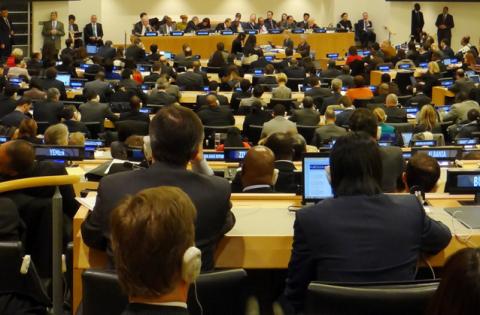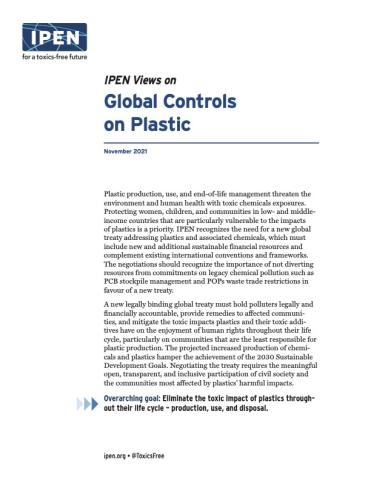Global Controls on Plastic


Plastic production, use, and end-of-life management threaten the environment and human health with toxic chemicals exposures. Protecting women, children, and communities in low- and middle-income countries that are particularly vulnerable to the impacts of plastics is a priority. IPEN recognizes the need for a new global treaty addressing plastics and associated chemicals, which must include new and additional sustainable financial resources and complement existing international conventions and frameworks. The negotiations should recognize the importance of not diverting resources from commitments on legacy chemical pollution such as PCB stockpile management and POPs waste trade restrictions in favour of a new treaty.
A new legally binding global treaty must hold polluters legally and financially accountable, provide remedies to affected communities, and mitigate the toxic impacts plastics and their toxic additives have on the enjoyment of human rights throughout their life cycle, particularly on communities that are the least responsible for plastic production. The projected increased production of chemicals and plastics hamper the achievement of the 2030 Sustainable Development Goals. Negotiating the treaty requires the meaningful open, transparent, and inclusive participation of civil society and the communities most affected by plastics’ harmful impacts.
Overarching goal: Eliminate the toxic impact of plastics throughout their life cycle – production, use, and disposal.
A new plastics and chemicals treaty must cover the following aspects:
Production
The key solution to address the impact of plastics is to scale down production and prohibit the use and addition of hazardous chemicals. Transforming fossil fuels into plastic resins and additives causes toxic releases in surrounding communities. Plastics that are produced with toxic additives, whether fossil-based or not, cannot be part of the “circular economy” and must be phased out. Extended producers’ responsibility programs should also ensure, through taxes, fees, and deposit return programs, that plastic producers take full responsibility for the impact of their products throughout their life cycle and are financially responsible for minimising them.
Use
To curb the negative health and environmental impacts of plastics, essential uses should be identified, and non-essential uses should be eliminated. The remaining plastics should be free of hazardous chemicals and designed for durability and reuse.
Transparency
Data on chemicals used and added to plastics should be publicly available throughout their life cycle, including through labelling, materials safety data sheets, and databases. Quantities of plastics produced, imported, exported, and disposed of should be monitored and the data publicly available to all.
End of Life
The management of current stockpiles of plastics must not release toxic chemicals, plastic litter or contribute to climate change. Only plastics that do not contain toxic chemicals should be recycled. Non-circular plastics (those containing toxic additives) should be identified, segregated, and safely disposed of. The export of plastic waste for disposal purposes should be prohibited and effective national collection and recycling systems should be funded. Burning plastic waste or associated derived fuels for energy in cement kilns, incinerators, or other combustion technologies is not circular, renewable, or sustainable and should be prohibited.
Financing Implementation and Compliance
A new treaty must generate new and additional sustainable financial resources for its implementation incorporating technical support and capacity building to support developing countries and economies in transition. Civil society should be able to have access to the funding. A review and compliance mechanism should be established to ensure that the goals of the treaty are achieved.
